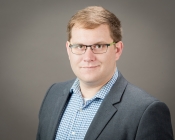Aaron Guest to address needs of older adults in rural communities across US

If you live in a major city, chances are you don’t spend much time thinking about what happens in smaller towns and rural areas. But Aaron Guest, an assistant professor at Arizona State University’s Edson College of Nursing and Health Innovation, says we need to change that.
“We can’t overlook the exchange between rural and urban areas; there is constant interaction,” Guest said. “You may not think, ‘I need to worry about what’s going on in this community,’ but what’s going on in that rural community is providing you the opportunity to live in the urban environment.”

An environmental gerontologist and researcher, Guest focuses on improving the lives of older adults in rural communities. He serves on the National Rural Health Association Age-Friendly Rural Communities Committee and is now stepping into a new role as a fellow in the organization’s prestigious Rural Health Fellows program.
The fellowship cultivates leaders who champion rural health and policy improvements across America. Guest is one of 18 fellows selected to participate in the 2025 program following a competitive review process.
“Rural health has always been important to me. I was thinking of the next steps in my rural research, and this provided a unique opportunity to get additional training, gain new expertise related to the policy process and collaborate nationally on rural health,” he said.
Below, Guest discusses his goals for the fellowship and why we all have a vested interest in rural health.
Question: Why should people who don’t live in rural communities pay attention to what’s happening there with health care?
Answer: Rural areas comprise 80% of the land mass in the U.S. and about 20% of the population — one in five, or 60 million people, live in rural communities. These places have historically provided the food, fuel and fiber that have powered our nation throughout its history.
We need to think about how we’re supporting individuals in these communities. Unfortunately, historically, public policy has disadvantaged health care in rural areas, and we must work to correct that as we move forward.
Q: What are your main goals for the yearlong fellowship program, and how do you hope it will impact rural health care?
A: The fellowship brings together academics, practitioners and rural health professionals from hospitals, clinics and public health departments. I’m excited to learn from them and contribute to informing policy, which is really what the fellowship focuses on: educating rural health leaders to champion rural health policy. I aim to add an aging lens to these discussions.
It also provides a unique opportunity to highlight what we’re doing here in Arizona and at ASU with our Age-Friendly initiatives and the Center for Innovation in Healthy and Resilient Aging at Edson College.
Q: In your view, what are the most pressing challenges facing rural health care today?
A: Easily, the main challenges are accessing and delivering care. That includes both the lack of facilities and providers. We know that individuals living in rural communities have longer travel times to access care. So if you have to drive three-plus hours to access care, you’re probably not going in for all of your necessary and preventative appointments.
When we look at lesbian and gay or other marginalized populations, it becomes even more difficult to access care, even getting medications or having a hospital to go to. In one of our studies, a participant told us that they’re afraid to get care in their community, so they drive eight hours to access care.
Arizona’s unique mix of rural and Indigenous lands presents additional hurdles. Our patchwork of rural health systems takes time to access. There’s a lot of focus on telehealth, but the reality is telehealth isn’t available in many communities because of the lack of broadband.
We also face challenges in Arizona, as they do everywhere, recruiting and retaining health care workers. Even if they go to these communities, the facilities might not be equipped to handle the cases they see or align with their training, which often occurs in urban environments.
But rural communities are also full of strengths that we must harness — including greater social cohesion and support — that can be leveraged to address these challenges.
Q: What is your hope for when the fellowship is over?
A: I hope to increase the engagement of practitioners and stakeholders in thinking about aging issues and the aging rural population. Almost one-fifth of our aging population lives in rural environments.
My goal as a gerontologist is to increase the viewpoint and spotlight on the aspect of gerontology so that we can work together to address these existing needs while also identifying and preparing to address emerging needs. It’s not enough just to have providers; we need people who are trained and familiar with the needs of older adults.
By Amanda Goodman | January 10, 2025 | Original Post
